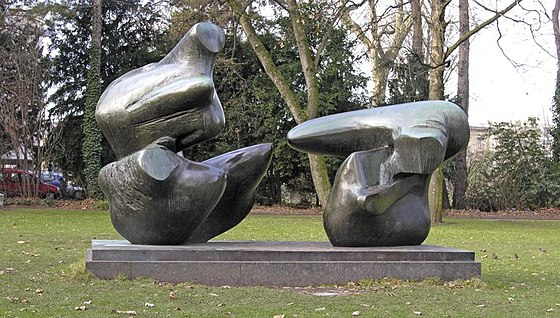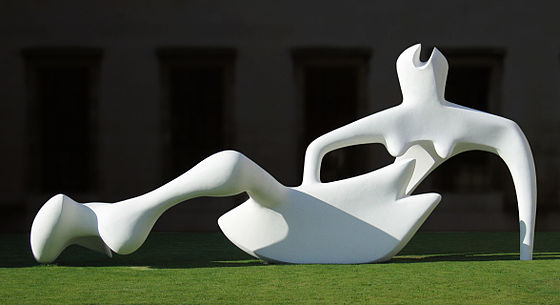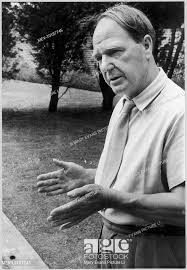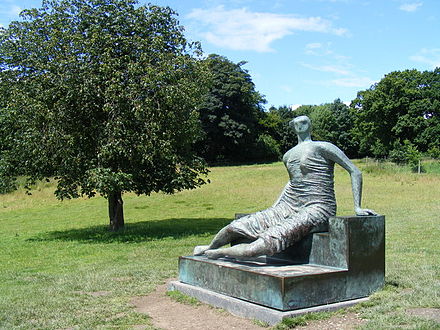
1898 - 1986
Henry Spencer Moore

description
The most famous and significant English sculptor of the post-war period, one of the founders of modernist British sculpture. Moore significantly influenced the gradual transformation of British sculpture from provincial to avant-garde, which not only corresponded to European concepts of modern art, but also introduced its themes and means of plastic expression.
Moore became world-famous thanks to his sculptures designed for open space, which are installed in many large cities around the world. These works, depicting mainly semi-abstract human figures, impress you with the harmony of their forms and musicality of smooth, winding lines. They reveal the eternal themes of the beauty of nature and the attractiveness of the female body, the spiritual closeness of a man and a woman, the selfless love of a mother for her child – all that makes our world more beautiful.
The sculptor preferred to cut his works from a whole piece of wood or stone, and began to use plaster and bronze casting only in the late period of his career. In addition to sculpture, Moore is known as a wonderful draftsman. His most significant works were impressive images of London citizens hiding in subway stations during Nazi bombings.
Key ideas:
– Almost all of Henry Moore’s sculptures were designed to be installed on the street, but not in the city, since the geometry of skyscrapers in megacities threatens sculpture; they were made for open space, a garden or park. Creating his masterpieces, the artist immediately chose a suitable place and a specific landscape for them.
– Unusual reclining figures are the hallmark of the master. They are metaphors of one landscape or another, where the chest and knees are like hills or gentle mountains, typical of the area where the artist was born and raised.
– The main theme of the sculptor’s work, which interested him throughout his career, was the theme of mother and child. Impressed by Christian paintings depicting Mary and her baby, Moore was able to express the warmth and tranquility emanating from these sincere relationships and a strong emotional connection in his sculptures.
– Most of Moore’s sculptures have unusual voids, indentations, and through holes in a solid mass of stone or metal. These holes make the work open to the surrounding landscape and allow the forms to flow seamlessly and organically into each other, creating images similar to the creations of nature.
– During the war, Moore proved to be a talented draftsman. Due to frequent bombing, the artist had to take refuge in the London Underground, where the majority of the city’s population was located. Mothers with children and entire families, forced to spend time in a cramped and dark room underground, became the heroes of his drawings. They are distinguished by a deep psychologism of images and emotional presentation.
1898
1917
1919
1921
1928
1932
1940
1950
1968
1986
The birth of the artist
Enlisted in the Prince of Wales' Own Civil Service Rifles

Was enrolled in the Leeds Art School

Won a scholarship to study at the Royal College of Art in London
Won a scholarship to study at the Royal College of Art in London, which he attended together with Hepworth and other students from Yorkshire. At that time, Moore became interested in primitive art, studying it at the British Museum. In London, the sculptor got acquainted with the works of modern authors such as Brancusi and Epstein.
The sculptor created his first public work

Moore became the director of the sculpture department at the Chelsea School of Art

He created many graphic images of Londoners

Family Group

Began working in graphic techniques, such as lithography and engraving

The death of the artist

Henry Spencer Moore
On Artist
flow
Constructivism
Abstract art
Surrealism
Cubism
friends
Barbara Heproot
Ben Nicholson
artists
Pablo Picasso
Hans Arp
Alberto Giacometti
Konstantin Brancusi
By Artist
flow
Abstract expressionism
friends
Anthony Caro
Frances Hodgkins
artists
Philip King
Isaac Whitkin
Helen Blumenfeld
Drago Marine Cherina
Lynn Russell Chadwick
Eduardo Paolozzi
Bernard Meadows
Reg Butler
William Turnbull
Robert Adams
Kenneth Armitage
Jeffrey Clark

